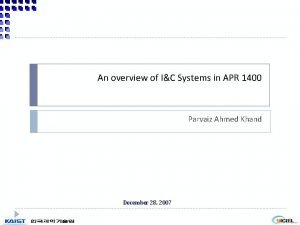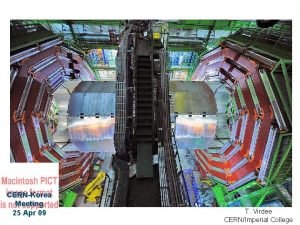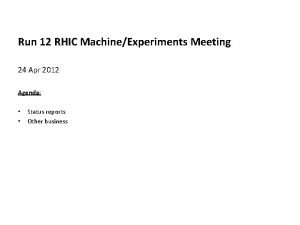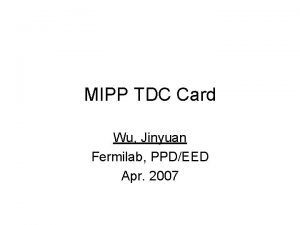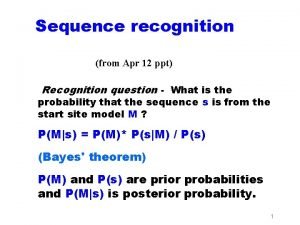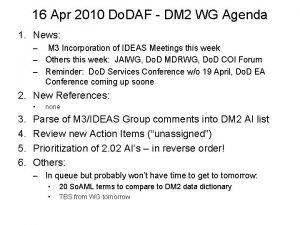Apr 24 Ch 7 Apr 26 Ch 8























- Slides: 23

• Apr 24 Ch 7 • Apr 26 Ch 8 Letter due • May 1 • May 3 Ch 8 Q 10, HW 9 • May 8 Ch 8? • May 10 Exam 3 (Ch 5, 7, 8) HW 10 • May 15 Review and Wrap-up

Chapter 8: Energy From Electron Transfer

Consider the Battery On the opposite end of the scale from the power plant is the battery Personal, portable power supply But what IS a battery? How does it work? Why can some be recharged and some can’t? Are there alternatives to traditional batteries? Can batteries (or their alternatives) help with the energy crunch?

Electrochemistry: Some Definitions A Battery: A system which converts chemical energy into electrical energy More correctly, a battery is an electrochemical cell: Galvanic Cells convert the energy from spontaneous chemical reactions into electricity Electrolytic Cells use electricity to drive nonspontaneous chemical reactions

Electrochemistry: Some Definitions All galvanic cells produce electricity from reactions which involve the transfer of electrons from one species to another There are two components to each cell – the species donating the electrons, and the species accepting them We write “half-reactions” to represent these two components, and to explicitly show the transfer of electrons

Electrochemistry: Some Definitions The oxidation half-reaction shows the species which is donating electrons The reduction half-reaction show the species which is receiving electrons We can also write the net reaction (or overall reaction) for the cell, the balanced sum of the two half-reactions LEO the lion says GER: Loss of Electrons is Oxidation; Gain of Electrons is Reduction

Electrochemistry: Some Definitions In a nickel-cadmium battery, the reactions look something like this: Oxidation Cd → Cd 2+ + 2 e 2 x [Reduction Ni 3+ + e- → Ni 2+ ] Net Cd + 2 Ni 3+ → Cd 2+ +2 Ni 2+ Note: The number of electrons given off in the oxidation half-reaction must equal the number gained in the reduction half-reaction Electrons moving from one place to another – this is electricity

Electrochemistry: Some Definitions Electrodes are electrical conductors in the cell where chemical reactions take place The anode is the electrode where oxidation takes place The cathode is the electrode where reduction takes place The cathode receives the electrons given off at the anode and passes them along The voltage of the whole cell is the electrical energy that it gives off, measured in volts (V) The current is the rate at which electrons pass through the cell, measured in amperes (A)

Fig. 08. p 360

Batteries: The Nickel-Cadmium Battery In a nickel-cadmium battery, the reactions actually look like this: Oxidation Cd(s) + 2 OH- (aq) → Cd(OH)2(s) + 2 e. Reduction 2 Ni. O(OH)(s) + 2 H 2 O(l) + 2 e- → 2 Ni(OH)2(s) + 2 OH- (aq) Net Cd(s) + 2 Ni. O(OH)(s) + 2 H 2 O(l) → Cd(OH)2(s) + 2 Ni(OH)2(s) Note: The number of reactions and the number of electrons hasn’t changed, but we’re more completely describing the physical and chemical form of the electrode components

The cell contains a paste of Na. OH – this provides the OH - ions needed for the reaction, while also providing a medium to pass charge (electrolyte) The anode consists of solid metal which is transformed into cadmium hydroxide The cathode consists of Ni 3+ ions in a Ni. O(OH) paste which are transformed into nickel hydroxide

It is because the products of the reaction are solids that the Ni-Cd battery can be recharged The solid hydroxides are sticky, cling to the innards of the battery, and remain in place. If current is applied, the reaction can be driven backwards!

Batteries: The Nickel-Cadmium Battery In a nickel-cadmium battery, we can recharge the battery by applying an electrical current from another source Cd(s) + 2 Ni. O(OH)(s) + 2 H 2 O(l) Cd(OH)2(s) + 2 Ni(OH)2(s) But most batteries we use aren’t rechargeable Why not? What are the properties of some other typical batteries?

Batteries: The Alkaline Battery Billions upon billions of alkaline batteries are used each year They are described by size and shape – AAA to D Larger batteries have more “stuff”, and thus can run longer But they all have the same voltage, because they’re all based on the same electrochemical cell

Batteries: The Alkaline Battery But they all have the same voltage, because they’re all based on the same electrochemical cell Oxidation Zn(s) + 2 OH- (aq) → Zn(OH)2(s) + 2 e. Reduction 2 Mn. O 2(s) + H 2 O(l) + 2 e- → Mn 2 O 3(s) + 2 OH- (aq) Net Zn(s) + 2 Mn. O 2(s) + H 2 O(l) → Zn(OH)2(s) + Mn 2 O 3(s)

But – the Mn 2 O 3 is not sticky, and doesn’t remain attached to the electrode. This battery is not rechargeable

Lithium-iodine batteries are particularly small and lightweight, but also very long-lived Often used in pacemakers, where they can last for 10 years

Mercury batteries take advantage of the high density of Hg to be quite small: used in watches, hearing aids, calculators, etc. Phased out in the 80 s due to the toxicity of Hg

Fig. 08. 05

Batteries: The Lead-Acid Battery Net: Pb(s) + Pb. O 2(s) + H 2 SO 4(aq) 2 Pb. SO 4(s) + 2 H 2 O(l) The cathode is made of metallic lead, and the anode of lead dioxide The electrolyte is sulfuric acid This reaction, too, is reversible. The lead sulfate product clings to the electrodes, so applied external voltage can reverse the reaction


Batteries: The Lead-Acid Battery Lead-acid batteries are referred to as “storage batteries”, because this charge-discharge cycle is so reliable These batteries were used in every automobile until quite recently The battery is discharged in order to start the engine Once the engine is running and burning gasoline, it turns an alternator which recharges the battery This process can continue for up to 5 years of normal driving After that time, enough of the lead sulfate product has been shaken off the plates that it can no longer recharge

Batteries: The Lead-Acid Battery Lead-acid batteries are also used in environments where vehicles cannot emit combustion products: Indoor forklifts, golf carts, handicapped carts in airports, wheelchairs However, lead is an environmental concern! How do we dispose of the millions and millions of batteries which die each year? There is a very succesful recycling program in the U. S. – 97% of spent batteries are recycled But environmentally healthier options are under investigation A leading contender is the magnesium-acid battery




















